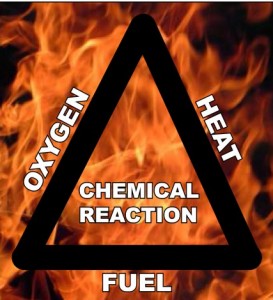
Many people aren't aware how fires start and spread throughout a building, but understanding the anatomy of fire and installing the correct equipment (like smoke detectors and suppression systems) beforehand, can allow you to better protect your property from damage.
The Fire Tetrahedron
The four components that must be present for a fire to occur are known as the fire tetrahedron. It is made up of:
- Oxygen
- Heat
- Fuel
- Chain Reaction
These four elements make combustion, a process which produces a great deal of heat, possible.. As a result of combustion, heat naturally flows to areas of lower temperature, which can cause a fire to spread.
Three Ways Heat Travels
There are three different ways that heat is transferred: conduction, convection and radiation.
1. Conduction
Heat can be transferred through direct contact, and this process is called conduction. The speed at which ittransfers, depends upon the material used to fuel the fire. For example, aluminum is an efficient conductor of heat, but cloth material is not. Using insulation and building materials, which conduct heat slowly, can help prevent fires from occurring or spreading.
Fires spread by conduction may work through a room more slowly and in a more consistent pattern than other methods,because items or materials must be physically touching for fire to spread this way.
2. Convection
Heat can also be transferred through gases or liquid,when the molecules within these substances are sped up. . Fire heats up the air in a room or building, and if it reaches a sufficiently high temperature, it can cause materials in the affected area to burst into flame.
Since hot air rises, fire spread due to convection typically moves up in a building rather than down.
3. Radiation
Distinct from convection, heat can also travel through the air in the form of waves. Sometimes referred to as infrared rays, this type of heat radiates outwards from the flames. When these waves strike an object, they heat up its surface - which may cause it to catch on fire.
Progression of Fire Spread
Fires most often begin in the contents of a building, such as furniture, drapes, clothing, newspapers and so on. These types of fires are much easier to extinguish if found early, which is why is important to always have an extinguisher on hand.
If left unchecked, a fire may spread to the structure of the building, making it much more difficult to extinguish. Most often, fire will move through hidden spaces in the building, such as the space between studs within the walls, attics and the vertical chases for pipes (mechanical systems and duct-work which run between floors). These hidden spaces can act like conduits for a fire to spread, and even when they only contain non-combustible material, it may not be enough to deter the movement of the blaze.
An Ounce of Prevention
As the old saying goes, “an ounce of prevention is worth a pound of cure.” This is especially true when it comes to fire. Purchasing fire extinguishers and installing smoke detectors, fire alarms and fire suppression or sprinkler systems, can help to prevent any fires from starting, or help to quickly extinguish any fire which does arise.
Please contact us online or call 1-888-456-8038 to learn how to safeguard your property.


